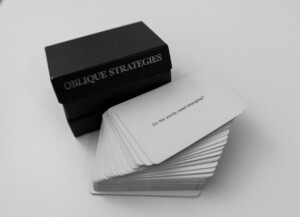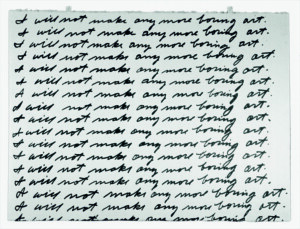Creative Content
El libro publicado en 1975 por Brian Eno y Peter Schmidt durante sus años de producción en Berlin no es ninguna novedad de divulgación, pero vale el hecho recordar que crearon algo revolucionario en su simplicidad que como toda estrategia creativa es atemporal y merece ser mencionada mil veces de ser necesario. El desarrollo de un mazo de cartas diseñado para desbloquear procesos creativos sin forzarlos se consolidó bajo el nombre de “Estrategias Oblicuas”. El juego, no ofrecía respuestas directas, sino desvíos sutiles. Cada carta contenía una frase breve, enigmática o incluso absurda, actuando como una pequeña interrupción a la lógica habitual. No era un método rígido, sino una invitación a vaciar la mente para ver las cosas con nuevos ojos.
Estas estrategias no buscaban la originalidad deslumbrante o la solución instantánea. Su propósito era torcer el curso de las ideas, desalinear el foco y permitir que lo inesperado se filtrara en el proceso creativo. En momentos de bloqueo, Eno tomaba una carta y, en lugar de buscar una respuesta lógica, reaccionaba desde la sorpresa. Así, la rigidez se aflojaba y la creación volvía a respirar.
Este gesto, aparentemente simple, encerraba una visión profunda: no todo proceso creativo requiere una dirección lineal. En lugar de atacar un problema de frente, las Estrategias Oblicuas sugieren convivir con él, rodearlo, repensarlo e incluso cuestionar su origen. Se trata de encontrar nuevas perspectivas sin juicio ni urgencia, de habitar la ambigüedad y aceptar la imperfección.
Tanto el pensamiento oblicuo como el lateral buscan romper con la lógica tradicional y desviar la mirada del camino obvio. Sin embargo, no son idénticos. El pensamiento lateral se enfoca en encontrar soluciones creativas a través de enfoques no convencionales; su meta es llegar a un lugar diferente. El pensamiento oblicuo, en cambio, no siempre persigue un objetivo concreto. A menudo, sus fines son más abstractos: la apertura, el desvío o la duda.
Vivimos saturados de herramientas que optimizan, predicen, corrigen y completan, al punto de que casi son una extensión de nosotros mismos. Medimos las horas de sueño, el tiempo frente a la pantalla y lo que consideramos “pérdida” cuando una actividad no genera un resultado visible. En este contexto, las Estrategias Oblicuas son más relevantes que nunca.
Para seguir creando, es fundamental resistir. Frente a la cultura del rendimiento y la lógica de la perfección, estas cartas reivindican el valor del error, del margen y de lo aparentemente inútil. La repetición se convierte en una forma de cambio. Lo aburrido, en una fuente de atención. Lo simple, en una vía legítima.
Crear desde esta perspectiva implica aceptar la pausa, desactivar el control y permitir que lo inesperado ocurra, no como un accidente, sino como una práctica intencional. Es un esfuerzo por volver a ser permeables, un acto de presencia consciente en tiempos de automatismo.
Para empezar a jugar con estas ideas, el siguiente sitio web ofrece una versión gratuita para explorar este enfoque:
Ideas mas remarcables que destaco
La repetición es una forma de cambio.
Haga algo aburrido.
Enfrentado con una elección, haga ambas. (Aportada por Dieter Rot)
Haga más humano lo que es perfecto.
Abandonar el deseo
Coraje!
Cuestioná lo heroico (podria resurmirse a solo cuestionar)
Descubrí tus fórmulas y abandonalas
Dónde está el borde?
No evites lo que es fácil
Sé menos crítico
Usá tus propias ideas
Share Post









